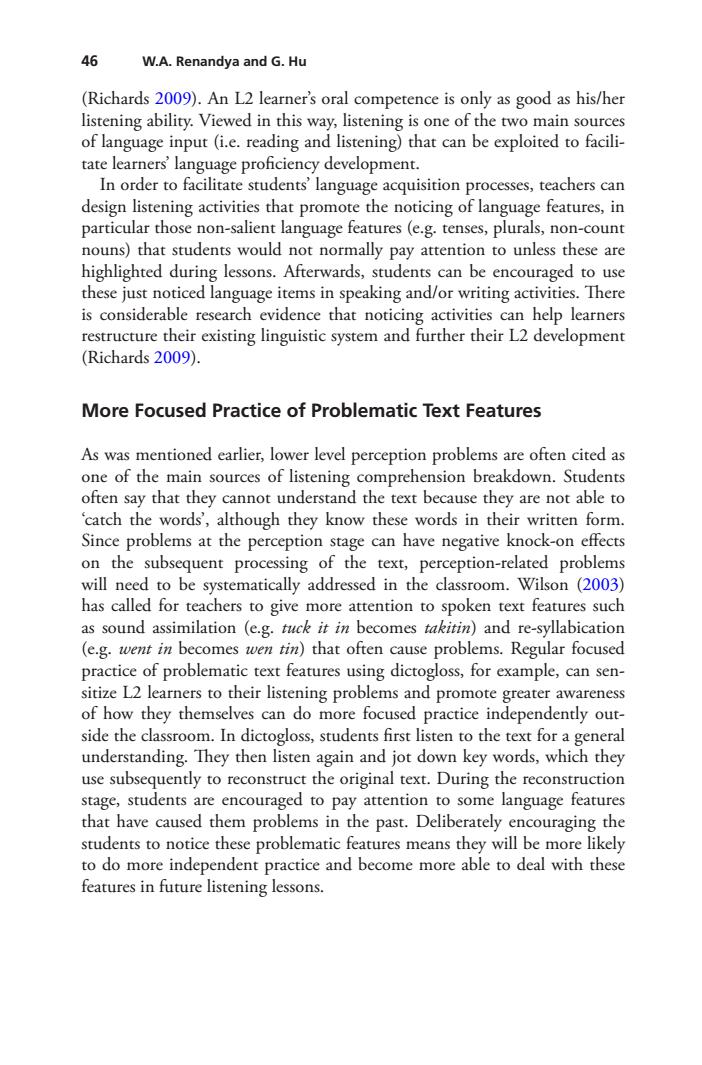正在加载图片...

6 W.A.Renandya and G.Hu (Richards 2009).An L2 learner's oral competence is only as good as his/her listening ability.Viewed in this way,listening is one of the two main sources of language input(i.e.reading and listening)that can be exploited to facili- tate learners'language proficiency development. In order to facilitate students'language acquisition processes,teachers can design listening activities that promoe the noticing of language features.in particular those non-salient language features (e.g.tenses,plurals,non-count nouns)that students would not normally pay attention to unless these are highlighted during lessons.Afterwards,students can be encouraged to use these just noticed language items in speaking and/or writing activities.There is considerable research evidence that noticing activities can help learners restructure their existing linguistic system and further their L2 development (Richards 2009). More Focused Practice of Problematic Text Features As was mentioned earlier,lower level perception problems are often cited as one of the main sources of listening comprehension breakdown.Students often say that they cannot understand the e text because they are not able to 'catch the words',although they know these words in their written form. Since problems at the perception stage can have negative knock-on effects on the subsequent processing of the text,perception-related problem will need to be systematically addressed in the classroom.Wilson (2003) has called for teachers to give more attention to spoken text features such as sound assimilation (e.g.tuck it in becomes takitin)and re-syllabication (e.g.went in becomes wen tin)that often cause problems.Regular focused practice of problematic text features using dictogloss,for example,can sen sitize L2 learners to their listening problems and promote greater awareness of how they themselves can do more focused practice independently out side the classroom.In dictogloss,students first listen to the text for a general understanding.They then listen again and jot down key words,which they use subsequently to reconstruct the original text.During the reconstruction stage,students are encouraged to pay attention to some language features that have caused them problems in the past.Deliberately encouraging the students to notice these problematic features means they will be more likely to do more independent practice and become more able to deal with these features in future listening lessons.46 W.A. Renandya and G. Hu (Richards 2009). An L2 learner’s oral competence is only as good as his/her listening ability. Viewed in this way, listening is one of the two main sources of language input (i.e. reading and listening) that can be exploited to facilitate learners’ language profciency development. In order to facilitate students’ language acquisition processes, teachers can design listening activities that promote the noticing of language features, in particular those non-salient language features (e.g. tenses, plurals, non-count nouns) that students would not normally pay attention to unless these are highlighted during lessons. Afterwards, students can be encouraged to use these just noticed language items in speaking and/or writing activities. Tere is considerable research evidence that noticing activities can help learners restructure their existing linguistic system and further their L2 development (Richards 2009). More Focused Practice of Problematic Text Features As was mentioned earlier, lower level perception problems are often cited as one of the main sources of listening comprehension breakdown. Students often say that they cannot understand the text because they are not able to ‘catch the words’, although they know these words in their written form. Since problems at the perception stage can have negative knock-on efects on the subsequent processing of the text, perception-related problems will need to be systematically addressed in the classroom. Wilson (2003) has called for teachers to give more attention to spoken text features such as sound assimilation (e.g. tuck it in becomes takitin) and re-syllabication (e.g. went in becomes wen tin) that often cause problems. Regular focused practice of problematic text features using dictogloss, for example, can sensitize L2 learners to their listening problems and promote greater awareness of how they themselves can do more focused practice independently outside the classroom. In dictogloss, students frst listen to the text for a general understanding. Tey then listen again and jot down key words, which they use subsequently to reconstruct the original text. During the reconstruction stage, students are encouraged to pay attention to some language features that have caused them problems in the past. Deliberately encouraging the students to notice these problematic features means they will be more likely to do more independent practice and become more able to deal with these features in future listening lessons